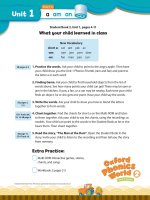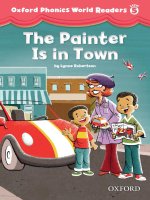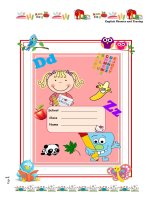Oxford Phonics World Level 2
Bạn đang xem bản rút gọn của tài liệu. Xem và tải ngay bản đầy đủ của tài liệu tại đây (3.41 MB, 12 trang )
Unit
1
short a
a am an
Student Book 2, Unit 1, pages 4-11
What your child learned in class
New Vocabulary
short a: cat ant yak ax
-am:
ram jam yam dam
-an:
fan man pan can
SB pages 4-9
1. Practice the words. Ask your child to point to the angry apple. Then have
your child show you the Unit 1 Phonics Friends (ram and fan) and point to
the letter a in each word.
2. Finding Game. Ask your child to find household objects from the list of
words above. See how many points your child can get! There may be yam or
jam in the kitchen. A pan, a fan, or a can may be nearby. Each time your child
finds an object, he or she gets one point. Have your child say the words.
SB pages 5,
7, 9
CD1 Tracks 06,
10, 14; SB page 5
SB page 11,
CD1 Track 16
3. Write the words. Ask your child to show you how to blend the letters
together to form words.
4. Chant together. Find the chants for short a on the Multi-ROM and listen
to them together. Ask your child to say the chants, using the recordings as
models. Your child can point to the words in the Student Book as he or she
hears them. Then chant together.
5. Read the story, “The Man at the Dam”. Open the Student Book to the
story. Invite your child to listen to the recording and then tell you the story
from memory.
Extra Practice:
Multi-ROM interactive games, stories,
chants, and songs
Workbook 2 pages 2-5
© Oxford University Press. Permission granted to reproduce for instructional use.
Unit
2
short a
ad ag ap at
Student Book 2, Unit 2, pages 12-19
What your child learned in class
New Vocabulary
-ad -ag: dad pad bag rag
cap map nap tap
-ap:
bat rat hat mat
-at:
SB pages 12-17
1. Practice the words. Ask your child to show you the Phonics Friends for
Unit 2 (dad, bag, cap, and bat) and point to ad, ag, ap, or at in each word.
2. A Still Life. Invite your child to find 4-6 of the Unit 2 vocabulary items
and place them together in a “still life.” Provide art supplies so your child
can draw the still life. Or, if a camera is available, help your child to take a
photograph of the scene. Later, have your child show his or her drawing or
photograph to other family members and name the objects shown.
SB pages 13,
15, 17
CD1 Tracks 18,
24, 29;
SB pages 13,
15, 17
SB page 19,
CD1 Track 31
3. Write the words. Ask your child to show you how to blend the letters
together to form words.
4. Chant together. Listen to the chants together. Then chant together along
with the recordings. After each chant, invite your child to try chanting alone,
without the recording.
5. Read the story “A Day with Dad.” Listen to the recording of the story with
your child. Then ask your child to tell you about his or her favorite part of
the story.
Extra Practice:
Multi-ROM interactive games, stories,
chants, and songs
Workbook 2 pages 6-9
© Oxford University Press. Permission granted to reproduce for instructional use.
Review
1
short a
a am an ad ag ap at
Student Book 2, Review 1, pages 20-23
What your child reviewed in class
short a:
-am:
-an:
-ad:
cat ant yak ax
ram jam yam dam
fan man pan can
dad pad
-ag: bag rag
-ap: cap map nap tap
-at: bat rat hat mat
1. Practice the words. Challenge your child to name all six Phonics Friends
from Units 1 and 2. Your child can use the Student Book for help, if needed.
SB page 20
SB page 20,
CD1 Track 29
SB pages 84-88
SB page 23
2. Points Game. Encourage your child to study the big picture on Student
Book page 20 and name as many items as he or she can. Give your child one
point for each item named. How many points can your child win? For extra
points, invite your child to pick out one or two favorite items and tell you
why he or she likes them.
3. Sing together. Listen to the song with your child. Listen again, pointing to
the appropriate areas of the picture in the Student Book. Then play the track
again and sing!
4. Write the words. Have your child look at the Picture Dictionary on pages
84-88 and find the Units 1 and 2 words. Provide paper and a pencil and
invite your child to write each word again.
5. Play the Game. With your child, play the game on page 23. Your child will
have already played this game in class, so ask him or her to tell you the
rules.
Extra Practice:
Multi-ROM interactive games, stories,
chants, and songs
Workbook 2 pages 10-11
© Oxford University Press. Permission granted to reproduce for instructional use.
Unit
3
short e
e et en ed
Student Book 2, Unit 3, pages 24-31
What your child learned in class
New Vocabulary
short e: web egg vet ten
-et:
jet net wet pet
-en -ed: hen pen red bed
SB pages 24-29
1. Practice the words. Ask your child to point to the energetic egg. Then
have your child show you the Unit 3 Phonics Friends (jet, hen, and red) and
point to the e in each word.
2. Drawing Game. Very slowly, draw a vocabulary item. Have your child
identify it as soon as he or she knows what it is. Then draw another item, or
invite your child to draw a Unit 3 item for you to identify.
SB pages 25,
27, 29
3. Write the words. Ask your child to show you how to blend the letters
together to form words.
CD1 Tracks 38,
42, 44;
SB pages 25,
27, 29
4. Chant together. Find the short e chants on the Multi-ROM and play
them at home or in the car. With your child, say the chants along with
the recordings.
SB page 31,
CD1 Track 48
5. Read the story “My Pet Hen.” Listen to the recording of the story and have
your child read along in the Student Book. Then, cover up the text and ask
your child to tell you what is happening in each picture.
Extra Practice:
Multi-ROM interactive games, stories,
chants, and songs
Workbook 2 pages 12-15
© Oxford University Press. Permission granted to reproduce for instructional use.
Unit
4
short i
i ip ib id
Student Book 2, Unit 4, pages 32-39
What your child learned in class
New Vocabulary
short i: hip ink zip in
-ip:
lip tip sip rip
-ib -id: bib rib kid lid
SB pages 32-37
1. Practice the words. Ask your child to point to the interesting insect. Then
have your child show you the Unit 4 Phonics Friends (lip, bib, and kid) and
point to the i in each word.
2. Charades. Take turns acting out all of the Unit 4 vocabulary and guessing
the words. For example, if you pretend are zipping up your jacket, your child
should say “Zip!”
SB pages 33,
35, 37
CD1 Tracks 52,
56, 58; SB 33,
35, 37
SB page 39,
CD1 Track 62
3. Write the words. Ask your child to show you how to blend the letters
together to form words.
4. Chant together. Find the short i chants on the Multi-ROM and play them
for your child. Invite your child to chant along. Accompany your child with
clapping, finger snapping, or other rhythmic sounds.
5. Read the story “The Kid.” Listen to the recording of the story and have
your child read along in the Student Book. Then have your child point to
and say the Sight Words at the bottom of the page.
Extra Practice:
Multi-ROM interactive games, stories,
chants, and songs
Workbook 2 pages 16-19
© Oxford University Press. Permission granted to reproduce for instructional use.
Review
2
short e
short i
e et en ed i ip ib id
Student Book 2, Review 2, pages 40-43
What your child reviewed in class
short e: -et -en -ed
short i: -ip -ib -id
1. Practice the words. Challenge your child to name all six Phonics Friends
from Units 3 and 4. Your child can use the Student Book for help, if needed.
SB page 40
SB page 40,
CD1 Track 63
SB pages 84-88
2. Points Game. Encourage your child to study the big picture on Student
Book page 40 and name as many items as he or she can. Give your child
one point for each item named. For extra points, invite your child to pick
out one or two favorite items and tell you why he or she likes them. How
many points can your child win? If you played the Points Game in Review 1,
compare your child’s scores.
3. Sing together. Listen to the song with your child. Listen again, pointing to
the appropriate areas of the picture in the Student Book. Then play the track
again and sing!
4. Write the words. Have your child look at the Picture Dictionary on pages
84-88 and find the Units 3 and 4 words. Provide paper and a pencil and
invite your child to write each word again.
5. Matching Game. Using the Student Picture Cards for Units 3 and 4, have
your child explore your home and match each card with an object (for
example, your child might place the bed card on a bed). For any unmatched
cards, invite your child to draw his or her own picture of the item (or action!)
shown on the card. Finally, have your child show you all of the matches and
say the words.
Extra Practice:
Multi-ROM interactive games, stories,
chants, and songs
Workbook 2 pages 20-21
© Oxford University Press. Permission granted to reproduce for instructional use.
Unit
5
short i
in ig it ix
Student Book 2, Unit 5, pages 44-51
What your child learned in class
-in:
-ig:
-it:
SB pages 44-49
New Vocabulary
pin fin bin win
fig wig big dig
pit hit six mix
1. Practice the words. Ask your child to show you the Unit 5 Phonics Friends
(pin, fig, pit, and six) and point to the i in each word.
2. Quick-Draw. Draw a picture of a Unit 5 vocabulary item. Have your child
close his or her eyes while you draw. Then, set a timer and have your child
look at the picture and try to name it as quickly as possible. You can also
invite two other family members or two friends to play as a team against
you. The team who guesses fastest wins a point in each round.
SB pages 45,
47, 49
CD2 Tracks 06,
10, 14;
SB pages 45,
47, 49
SB page 51,
CD2 Track 16
3. Write the words. Ask your child to show you how to blend the letters
together to form words.
4. Chant together. Find the short i chants on the Multi-ROM. Ask your child
to say the chants, using the recordings as models. Your child can point
to the words in the Student Book as he or she hears them. Finally, chant
together.
5. Read the story “Help!” Listen to the recording of the story and have your
child read along in the Student Book. Then ask your child to tell you about
his or her favorite part of the story.
Extra Practice:
Multi-ROM interactive games, stories,
chants, and songs
Workbook 2 pages 22-25
© Oxford University Press. Permission granted to reproduce for instructional use.
Unit
6
short o
o ot op
Student Book 2, Unit 6, pages 52-59
What your child learned in class
New Vocabulary
short o: fox log ox rod
-ot:
pot hot cot dot
-op:
top mop hop pop
SB pages 52-57
1. Practice the words. Ask your child to point to the orange octopus. Then
have your child show you the Unit 6 Phonics Friends (pot and top) and point
to the ot or op in the words.
2. Out and About. Take your child for a walk around your neighborhood.
Invite your child to look for vocabulary items from Unit 6.
SB pages 53,
55, 57
CD2 Tracks 20,
24, 28;
SB pages 53,
55, 57
SB page 59,
CD2 Track 30
3. Write the words. Ask your child to show you how to blend the letters
together to form words.
4. Chant together. Find the short o chants on the Multi-ROM and play them
for your child. Invite your child to chant along. Accompany your child with
clapping, finger snapping, or other rhythmic sounds.
5. Read the story “The Fox.” Listen to the recording of the story and have
your child read along in the Student Book. Then close the Student Book and
have your child tell you the story from memory.
Extra Practice:
Multi-ROM interactive games, stories,
chants, and songs
Workbook 2 pages 26-29
© Oxford University Press. Permission granted to reproduce for instructional use.
Review
3
short i
short o
in ig it ix o ot op
Student Book 2, Review 3, pages 60-63
What your child reviewed in class
short i: in ig it ix
short o: o ot op
1. Practice the words. Challenge your child to name all six Phonics Friends
from Units 5 and 6. Your child can use the Student Book for help, if needed.
SB page 60
SB page 60,
CD1 Track 31
SB pages 84-88
2. Points Game. Encourage your child to study the big picture on Student
Book page 60 and name as many items as he or she can. Give your child one
point for each item named. For extra points, invite your child to pick out
one or two favorite items and tell you why he or she likes them. How many
points can your child win? If you played the Points Game in Reviews 1 and 2,
compare your child’s scores.
3. Sing together. Listen to the song with your child. Listen again, pointing to
the appropriate areas of the picture in the Student Book. Then play the track
again and sing!
4. Write the words. Have your child look at the Picture Dictionary on pages
84-88 and find the Units 5 and 6 words. Provide paper and a pencil and
invite your child to write each word again.
5. Memory Game. Use the Student Picture and cut out Word Cards from
the Parents’ website Units 5 and 6. Mix up the cards and arrange them
facedown in a grid. Invite your child to turn over two cards, looking for a
word and its picture. Your child should turn the cards back over if they don’t
match. Next, you take a turn. Keep matched cards. Continue until all cards
have been matched. Who found the most matches?
Extra Practice:
Multi-ROM interactive games, stories,
chants, and songs
Workbook 2 pages 30-31
© Oxford University Press. Permission granted to reproduce for instructional use.
Unit
7
short u
u ug ud up
Student Book 2, Unit 7, pages 64-71
What your child learned in class
New Vocabulary
u:
sun up jug hug
-ug:
bug rug mug
-ud -up: bud mud pup cup
SB pages 64-69
1. Practice the words. Ask your child to point to the unhappy umbrella. Then
have your child show you the Unit 7 Phonics Friends (bug, bud, and pup)
and point to the u in each word.
2. Picture Search. Have your child find pictures of the Unit 7 vocabulary items
in books and magazines or on the Internet. There are 11 words. How many
can your child find?
SB pages 65,
67, 69
CD2 Tracks 37,
41, 45; SB 65,
67, 69
SB page 71,
CD2 Track 47
3. Write the words. Ask your child to show you how to blend the letters
together to form words.
4. Chant together. Find the short u chants on the Multi-ROM and play them
at home. Play the tracks and chant together as you make dinner, clean up,
and do other household activities.
5. Read the story “The Mud.” Listen to the recording of the story and have
your child read along in the Student Book. Then cover up the text and ask
your child to tell you what is happening in each picture.
Extra Practice:
Multi-ROM interactive games, stories,
chants, and songs
Workbook 2 pages 36-39
© Oxford University Press. Permission granted to reproduce for instructional use.
Unit
8
short u
ut ub um un
Student Book 2, Unit 8, pages 72-79
What your child learned in class
New Vocabulary
short u: nut hut cut
-ub -um: cub tub gum hum
-un:
bun run fun
SB pages 72-79
1. Practice the words. Ask your child to point to the noisy nut. Then have
your child show you the Unit 8 Phonics Friends (cub, gum, and bun) and
point to the ub, um, or un in the words.
2. Guessing Game. Hold up the Unit 8 Student Picture Cards one at a time,
with the picture facing you (so your child can’t see it!). Have your child try to
guess what is shown on each card. For each correct guess, your child wins a
point. Be sure to have your child identify all of the words on the cards.
SB pages 73,
75, 77
CD2 Tracks 52,
56, 60;
SB pages 73,
75, 77
SB page 79,
CD2 Track 62
3. Write the words. Ask your child to show you how to blend the letters
together to form words.
4. Chant together. Find the short u chants on the Multi-ROM and play them
for your child. Invite your child to chant along. Accompany your child with
clapping, finger-snapping, or other rhythmic sounds.
5. Read the story “Friends.” Listen to the recording of the story and have
your child read along in the Student Book. Then have your child read the
story to you.
Extra Practice:
Multi-ROM interactive games, stories,
chants, and games
Workbook 2 pages 36-39
© Oxford University Press. Permission granted to reproduce for instructional use.
Review
4
short u
u ug ud up ut ub um un
Student Book 2, Review 4, pages 80-83
What your child reviewed in class
short u: ug ud up ut ub um un
1. Practice the words. Challenge your child to name all six Phonics Friends
from Units 7 and 8. Your child can use the Student Book for help, if needed.
SB page 80
SB page 80,
CD1 Track 63
SB pages 84-88
SB page 83
2. Points Game. Encourage your child to study the big picture on Student
Book page 80 and name as many items as he or she can. Give your child one
point for each item named. For extra points, invite your child to pick out
one or two favorite items and tell you why he or she likes them. How many
points can your child win? If you played Points Game in Reviews 1, 2, and 3,
compare your child’s scores.
3. Sing together. Listen to the song with your child. Listen again, pointing to
the appropriate areas of the picture in the Student Book. Then play the track
again and sing!
4. Write the words. Have your child look at the Picture Dictionary on pages
84-88 and find the Units 7 and 8 words. Provide paper and a pencil and
invite your child to write each word again.
5. Play the Game. With your child, play the game on page 83. Your child will
have already played this game in class, so ask him or her to tell you the
rules.
Extra Practice:
Multi-ROM interactive games, stories,
chants, and songs
Workbook 2 pages 40-41
© Oxford University Press. Permission granted to reproduce for instructional use.









